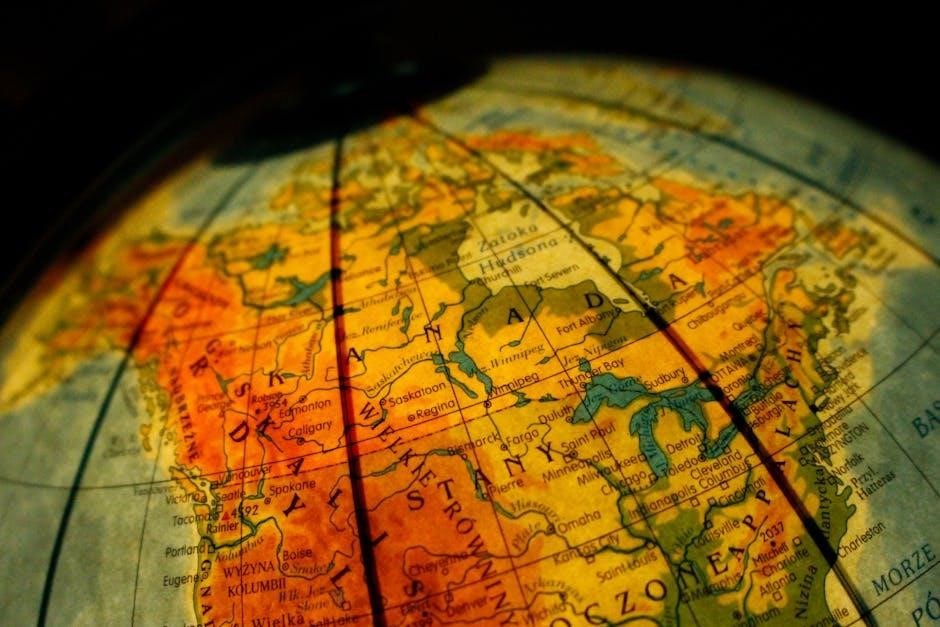This book by Tom Standage explores how six beverages—beer, wine, spirits, coffee, tea, and Coca-Cola—have shaped human history, offering a unique lens to understand global development and cultural transformation across centuries.
Overview of the Book’s Concept
Tom Standage’s A History of the World in Six Glasses offers a fresh perspective on global history by tracing the impact of six beverages: beer, wine, spirits, coffee, tea, and Coca-Cola. Each drink represents a distinct era, from ancient civilizations to modern globalization. The book reveals how these beverages influenced culture, trade, and societal development, serving as catalysts for significant historical events and cultural shifts. This unique approach connects everyday consumption to broader economic and social transformations, providing a compelling narrative of human progress.
Importance of Beverages in Shaping Human History
Beverages have played a pivotal role in shaping human history, driving cultural, economic, and social transformations. From the birth of civilization to modern times, drinks like beer, wine, and coffee have influenced trade, religion, and innovation. They facilitated global connections, sparked revolutions, and became symbols of power and identity. By examining these liquids, the book reveals how everyday consumption shaped monumental historical events, highlighting the profound impact of beverages on human progress and global interconnectedness.
The Six Beverages and Their Historical Significance
Six iconic beverages—beer, wine, spirits, coffee, tea, and Coca-Cola—each represent distinct eras, shaping human history through cultural, economic, and social transformations that defined civilizations and globalization.
Beer: The Dawn of Civilization
Beer emerged in the Fertile Crescent around 3000 B.C.E., becoming a cornerstone of Mesopotamia and Egypt. It facilitated settled agriculture, served as currency, and strengthened social bonds, playing a pivotal role in the transition from nomadic life to civilization. Its significance extended beyond nourishment, influencing religious rituals and cultural practices, making it a foundational element in the development of complex societies and early urban centers.
Wine: The Drink of Ancient Greece and Rome
Wine was central to ancient Greek and Roman culture, serving as a symbol of wealth, religion, and social status. In Greece, it facilitated philosophical debates in symposia, while in Rome, it became a staple of daily life and trade. Wine’s influence extended to medicine, rituals, and art, shaping the cultural and political landscapes of these civilizations and leaving a lasting legacy in Western traditions and practices.
Spirits: The Age of Exploration and Colonization
Spirits, particularly rum and brandy, played a pivotal role during the Age of Exploration and colonization. They served as currency in trade, facilitated the establishment of colonies, and were integral to the transatlantic slave trade. Spirits also fueled naval expeditions and became a staple in colonial economies. Their production and trade shaped global power dynamics, influencing the rise of European empires and the exploitation of resources, leaving a lasting impact on the social and economic structures of the time.
Coffee: The Spark of the Enlightenment
Coffee emerged in the Middle East and spread rapidly across Europe, becoming a catalyst for intellectual and cultural transformation. Coffeehouses served as hubs for debates, fostering the exchange of ideas among philosophers, scientists, and thinkers. This environment nurtured the Enlightenment, promoting reason, innovation, and scientific inquiry. Coffee’s influence extended beyond intellectual circles, shaping social norms and political discourse, making it a cornerstone of the cultural and intellectual shifts that defined the 18th century and beyond.
Tea: The Rise of Global Trade and Empire
Tea, originating in China, became a cornerstone of global trade, particularly through the British East India Company. Its popularity in Britain fueled imperial expansion, with colonies established to secure tea supplies and trade routes. The Opium Wars and the exploitation of Indian tea plantations highlight tea’s role in shaping empires. Tea also influenced British culture, becoming a staple in daily life and symbolizing both national identity and colonial power, deeply embedding itself in the fabric of global history and trade dynamics.
Coca-Cola: The Era of Industrialization and Globalization
Coca-Cola emerged in the late 19th century, symbolizing the rise of industrialization and mass production. Invented by John Pemberton, it quickly became a global icon, leveraging innovative marketing and distribution strategies. The drink’s spread mirrored the expansion of American culture, becoming a symbol of globalization. Coca-Cola’s impact on consumer culture, branding, and international trade highlights its role in shaping modern society, embodying the transition from traditional beverages to the homogenized, mass-produced drinks of the contemporary world.

Beer: The First Glass
Beer’s origins in the Fertile Crescent marked the dawn of civilization, becoming central to Mesopotamia and Egypt, where it served as currency, strengthened social bonds, and shaped culture.
Origins of Beer in the Fertile Crescent
Beer traces its origins to the Fertile Crescent, where ancient civilizations first discovered fermentation around 10,000 BCE. Made from emmer wheat and barley, it became a staple in Mesopotamia and Egypt. Early evidence, such as clay tablets and brewery remains, highlights its importance in daily life, religion, and trade. The Epic of Gilgamesh even references beer, underscoring its cultural significance. Its discovery marked a turning point in human history, fostering settlement and the rise of complex societies.
Beer’s Role in Mesopotamia and Ancient Egypt
Beer was a fundamental commodity in Mesopotamia and Ancient Egypt, serving as currency, a religious offering, and a staple in daily life. In Mesopotamia, it was used to pay workers and seal transactions, while in Egypt, it was offered to gods and consumed during rituals. Its production and distribution were tightly controlled, reflecting its economic and cultural importance. Beer also provided a safer alternative to contaminated water, ensuring its ubiquity in both civilizations and cementing its role in their societies and traditions.
Beer as a Form of Currency and Social Bonds
Beer served as a vital form of currency in ancient Mesopotamia and Egypt, facilitating trade and social interactions. Workers were often paid in beer, which also acted as a medium of exchange for goods and services. This practice strengthened economic systems and fostered trust within communities. Additionally, beer played a key role in social bonding, as communal drinking rituals promoted unity and cooperation, further embedding its significance in both cultural and economic life during these eras.

Wine: The Second Glass
Wine was central to ancient Greek and Roman culture, influencing religion, social life, and trade. It symbolized wealth and power, shaping civilizations and traditions profoundly.
Wine in Ancient Greece and Rome
Wine played a central role in ancient Greek and Roman civilizations, serving as a staple in both religious and social contexts. In Greece, it was associated with Dionysus, the god of wine and festivities, while the Romans adopted and refined winemaking techniques. Wine was not only a drink but also a symbol of wealth and status, often used in trade and as a form of currency. Its influence extended to art, literature, and daily life, becoming an integral part of their cultural identity. The legacy of Greek and Roman winemaking traditions continues to shape viticulture and oenology today.
Wine’s Influence on Religion and Culture
Wine deeply influenced religious rituals and cultural practices in ancient civilizations. In Christianity, it became a sacred symbol through the Eucharist, representing the blood of Christ. Similarly, in Greek mythology, Dionysus, the god of wine, was celebrated for his role in festivals and theater. Wine also shaped social hierarchies, with its production and consumption often reflecting the wealth and power of elites. Its cultural significance extended to art, literature, and daily life, cementing its role as a cornerstone of Western civilization. Wine’s enduring legacy highlights its profound impact on human culture and spirituality.
Wine as a Symbol of Wealth and Power
Wine became a potent symbol of wealth and power, particularly in ancient Rome and Greece. Elite classes used expensive wines to showcase their status, often serving rare vintages at lavish banquets. Ownership of vineyards was a mark of prosperity, and the ability to afford high-quality wine signified social standing. Wine was also used as a tool for political influence, reinforcing alliances and hierarchies. Its exclusivity and luxury made it a visible representation of power, distinguishing the elite from the common populace in both cultural and economic spheres.

Spirits: The Third Glass
Spirits emerged during the Age of Exploration, fueling colonization and trade. They facilitated cultural exchange but also brought challenges to societies and empires.
The Rise of Distillation in the Middle Ages
Distillation emerged as a transformative process during the Middle Ages, originating in the Islamic world and spreading to Europe. This technique allowed for the creation of potent spirits, which were initially used for medicinal purposes. Monasteries became key centers for refining distillation methods, leading to the production of brandies and whiskeys. The rise of spirits marked a shift from fermented beverages like beer and wine, offering new ways to preserve and consume alcohol, while also influencing cultural practices and trade networks.
Spirits and the Age of Exploration
Spirits played a pivotal role during the Age of Exploration, as they became a valuable commodity in global trade and colonization. European explorers used brandy and other distilled beverages to barter with indigenous populations, facilitating the exchange of goods and resources; Spirits also served as a form of currency in the transatlantic slave trade, further entrenching their influence in the expansion of empires. Their potency and longevity made them ideal for long voyages, shaping the economic and social dynamics of the era while fueling both progress and exploitation.
Spirits in the Context of Colonialism
Spirits played a central role in colonialism, serving as both a tool of exploitation and a medium of exchange. European colonizers used distilled beverages to facilitate the transatlantic slave trade, exchanging spirits for enslaved people in West Africa. Additionally, spirits were used to exploit indigenous populations, undermining local cultures and social structures. The trade in spirits also fueled the expansion of empires, as it provided a lucrative commodity for colonial powers. This exchange deeply impacted the cultural and social norms of colonized regions, leaving a lasting legacy in global history.
Coffee: The Fourth Glass
Coffee emerged in the Middle East, spreading to Europe and fueling intellectual movements. Its stimulating effects made it a catalyst for Enlightenment ideas and scientific advancements, shaping modern thought and culture.
Coffee’s Origins and Spread Across the Middle East
Coffee originated in Ethiopia, where legend traces it to a goatherd who noticed energized goats after eating red berries. By the 15th century, it spread across the Arabian Peninsula, becoming central to social and religious life. The first coffeehouses emerged in Mecca and Cairo, serving as vibrant hubs for intellectual discourse and cultural exchange, fostering a rich tradition that would later influence global coffee culture and enlightenment movements.
Coffeehouses as Centers of Intellectual and Political Activity
Coffeehouses in the Middle East and Europe became hubs for lively debates and intellectual exchange. Scholars, artists, and politicians gathered to discuss ideas, fostering a culture of free thought. These spaces played a crucial role in the Enlightenment, facilitating the spread of scientific and philosophical knowledge. Coffeehouses also served as platforms for political dissent, influencing revolutions and shaping modern democracy. Their impact on society was profound, making them catalysts for cultural and political transformation.
Coffee’s Role in the Enlightenment and Scientific Revolution
Coffee’s arrival in Europe sparked a cultural and intellectual awakening. The beverage’s stimulating effects fueled debates and discussions in coffeehouses, which became hotbeds of Enlightenment thought. Thinkers like Isaac Newton and Voltaire frequented these spaces, exchanging ideas that drove scientific and philosophical progress. Coffee’s association with rationality and innovation made it a symbol of the Scientific Revolution, bridging the gap between science and society and laying the groundwork for modern intellectual discourse.
Tea: The Fifth Glass
Tea’s journey from China to global dominance shaped trade, culture, and empires. Its influence extended beyond Britain, fueling globalization and leaving a lasting mark on world history.
Tea’s Roots in China and Its Global Expansion
Tea originated in China over 4,000 years ago, becoming a staple in Chinese culture and trade. Its global expansion began via the Silk Road, reaching Europe by the 17th century. The British East India Company played a pivotal role in popularizing tea worldwide, especially in Britain, where it became a cultural icon. Tea’s journey from China to global markets not only shaped trade routes but also influenced colonial empires, fostering economic ties and cultural exchanges that reshaped the world.
Tea’s Impact on British Culture and Empire
Tea became central to British life, shaping social rituals like afternoon tea and influencing daily routines. The British East India Company’s dominance in tea trade fueled imperial expansion, with tea symbolizing British identity and power. Its popularity funded colonial ventures and shaped global trade networks. Tea also played a role in political tensions, such as the Boston Tea Party, highlighting its impact on empire-building and cultural identity, making it a cornerstone of British heritage and global influence.
Tea and the Opium Wars
Tea played a pivotal role in the Opium Wars, as Britain’s insatiable demand for Chinese tea created a trade imbalance. To offset this, British traders sold opium to China, leading to widespread addiction and conflict. The First Opium War (1839-1842) resulted in the Treaty of Nanking, which ceded Hong Kong to Britain and opened Chinese ports to British goods, further entrenching tea’s role in global trade and imperial power dynamics.
Coca-Cola: The Sixth Glass
Coca-Cola, invented in 1886, symbolizes modern globalization. Its rise reflects industrialization, mass production, and branding, becoming a cultural icon of American influence worldwide.
Coca-Cola’s Invention and Rise to Fame
Coca-Cola was invented in 1886 by pharmacist John Pemberton in Atlanta, Georgia. Initially marketed as a brain tonic, it quickly gained popularity due to its unique taste and innovative advertising. The drink became a cultural phenomenon, spreading nationally by the early 20th century. Its iconic contour bottle, introduced in 1915, symbolized global recognition. By the mid-1900s, Coca-Cola had become a worldwide symbol of American culture, embodying modern consumerism and globalization.
Coca-Cola as a Symbol of American Culture and Globalization
Coca-Cola embodies American culture, representing consumerism, innovation, and mass production. Its global presence symbolizes U.S. influence worldwide, adapting to local tastes while maintaining its iconic brand identity. Available in over 200 countries, Coca-Cola bridges cultural divides, reflecting and shaping global preferences. It stands as a testament to globalization’s power, blending tradition with modernity and showcasing how a single product can resonate universally, becoming a cultural ambassador for American values and lifestyles.
Coca-Cola’s Role in Modern Consumer Culture
Coca-Cola has become a cornerstone of modern consumer culture, symbolizing mass production, branding, and globalization. Its widespread availability and consistent taste have made it a universal product, adapting to diverse markets while maintaining a uniform identity. Coca-Cola’s marketing strategies, from iconic bottle designs to global campaigns, have influenced consumer behavior and preferences. It reflects and shapes cultural trends, embodying the intersection of tradition and innovation in a globalized world. Its enduring success highlights the power of consumer culture in shaping modern society.
The Book’s Structure and Narrative Style
Tom Standage’s engaging narrative divides history into six eras, each defined by a signature drink, offering a fresh perspective on global events and cultural shifts.
Tom Standage’s Unique Approach to Historical Narrative
Tom Standage crafts a compelling narrative by linking six beverages to pivotal historical eras, providing a fresh perspective on global development. His approach blends detailed historical research with engaging storytelling, making complex events accessible. By focusing on the cultural, economic, and social impacts of beer, wine, spirits, coffee, tea, and Coca-Cola, Standage offers a distinctive lens to view human civilization’s evolution. This method bridges the gap between academic history and popular narrative, appealing to a broad audience.
Each Glass as a Lens for Understanding Historical Eras
Each beverage in “A History of the World in Six Glasses” represents a distinct era, from ancient civilizations to modern globalization. Beer symbolizes the rise of agriculture and urbanization, while wine reflects the cultural dominance of Greece and Rome. Spirits mark the Age of Exploration, coffee sparks the Enlightenment, tea drives global trade, and Coca-Cola embodies industrialization. Together, these glasses provide a unique perspective on how beverages have shaped the flow of human history and cultural transformation across millennia.
The Interplay Between Beverages and Global Events
Beverages have played a pivotal role in shaping global events, influencing trade, politics, and society. From the spread of spirits during exploration to coffee fueling Enlightenment ideas, each drink intertwined with historical milestones. Tea drove British imperial expansion, while Coca-Cola symbolized American cultural dominance. Standage’s narrative reveals how these liquids not only reflected but also actively shaped the course of human history, connecting economies, cultures, and empires across the globe in unexpected yet profound ways.
Tom Standage’s Background and Contributions
Tom Standage is a historian and writer known for his innovative approach to historical narratives, notably “A History of the World in Six Glasses,” which connects everyday beverages to major historical events, making history accessible and engaging. His work contributes significantly to historical analysis through its unique perspective and engaging storytelling.
Tom Standage as a Historian and Writer
Tom Standage is a renowned historian and writer celebrated for his engaging and innovative approach to historical narratives. His work, such as “A History of the World in Six Glasses,” blends meticulous research with storytelling to make history accessible. Standage’s ability to connect everyday items like beverages to major historical events showcases his unique perspective. He has authored several books, including “An Edible History of Humanity,” further solidifying his reputation as a masterful interpreter of history’s cultural and political dimensions.
His Other Works and Their Relevance to Historical Analysis
Tom Standage’s other works, such as “An Edible History of Humanity,” further showcase his ability to connect everyday subjects to broader historical themes. His writing often employs a unique, interdisciplinary approach, blending culinary, cultural, and political history. Standage’s books are praised for their accessibility, making complex historical concepts engaging for a wide audience. His work consistently highlights how ordinary items, like food and drink, have shaped global events, offering fresh perspectives on traditional historical narratives.

Modern Relevance and Legacy of the Book
“A History of the World in Six Glasses” remains a celebrated work, influencing historical studies and popular culture. Its unique perspective continues to captivate readers globally, ensuring its enduring legacy as a fresh and engaging approach to understanding global history.
The Book’s Reception and Impact on Historical Studies
“A History of the World in Six Glasses” has been widely praised for its innovative approach to historical narrative. Historians and readers alike have commended its ability to weave together cultural, economic, and social histories through the lens of six beverages. The book’s engaging style has made it accessible to a broad audience, while its meticulous research has earned it respect in academic circles. Its unique perspective has inspired new ways of understanding global history, leaving a lasting impact on historical studies and popular culture.
Adaptations and Popular Culture References
The book has inspired various adaptations, including a docu-series hosted by Dan Aykroyd, bringing its unique historical perspective to a wider audience. References to the book appear in popular culture, with its engaging narrative style making it a favorite among educators and content creators. Its influence extends beyond academia, sparking conversations and adaptations that continue to captivate audiences worldwide, ensuring its legacy as a cultural and historical touchstone.
The book concludes by emphasizing how six beverages shaped human history, offering a unique perspective on global development and cultural transformation through their enduring influence.
The Enduring Influence of Beverages on Human History
Beverages like beer, wine, spirits, coffee, tea, and Coca-Cola have profoundly shaped human history, influencing culture, economy, and society across centuries. From ancient Mesopotamia to modern globalization, these drinks served as catalysts for cultural exchange, technological advancement, and social change. Their impact extends beyond refreshment, reflecting the values and priorities of their eras. By examining these six glasses, we gain a unique understanding of how everyday substances have driven human progress and left a lasting legacy on the world.
The Book’s Contribution to Understanding Global History
Tom Standage’s “A History of the World in Six Glasses” offers a fresh perspective on global history by tracing the impact of six beverages—beer, wine, spirits, coffee, tea, and Coca-Cola—across different eras. By linking these drinks to pivotal historical events and cultural shifts, the book provides a compelling narrative that connects everyday consumption to broader themes of trade, innovation, and societal change. This unique approach bridges the gap between micro and macro history, making the past accessible and engaging for readers worldwide.

References and Further Reading
For deeper exploration, download the PDF of “A History of the World in Six Glasses” by Tom Standage or explore online resources, reviews, and summaries available on platforms like Internet Archive and academic databases.
Key Sources and Recommended Materials
Tom Standage’s “A History of the World in Six Glasses” is available as a PDF download, offering a comprehensive exploration of beverages shaping global history. Additional sources include “An Edible History of Humanity” by Standage, as well as academic articles and reviews from platforms like Internet Archive and Google Scholar. For further insight, explore historical studies on beverages, cultural analyses, and economic impacts highlighted in the book. These materials provide a rich foundation for understanding the interplay of drinks and global events.
Online Resources for “A History of the World in Six Glasses”
Online resources for “A History of the World in Six Glasses” include free PDF downloads on platforms like Internet Archive and paid versions on Amazon. Additionally, a docu-series hosted by Dan Aykroyd on Fox Nation explores the book’s themes. Websites like Google Books and scholarly articles provide further insights, while reviews and summaries on Bloomberg and The Boston Globe offer critical perspectives. These resources enhance understanding of the book’s historical and cultural significance.